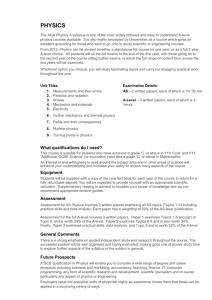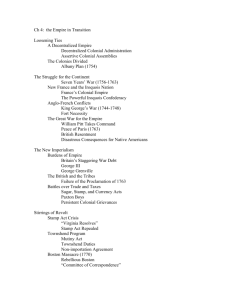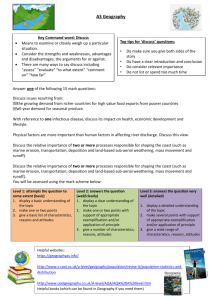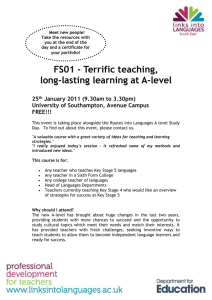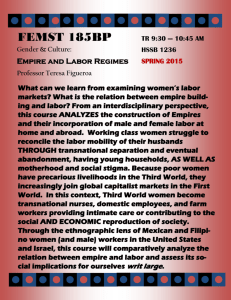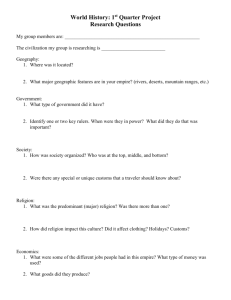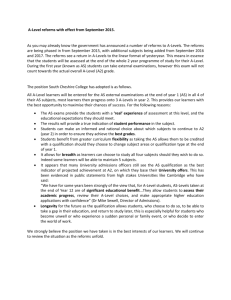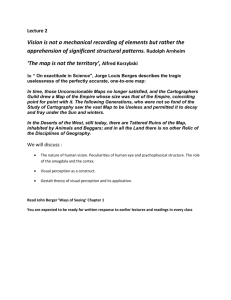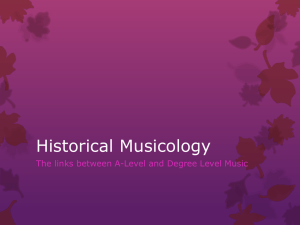Edexcel A-Level History (for students starting Year 12 from
advertisement
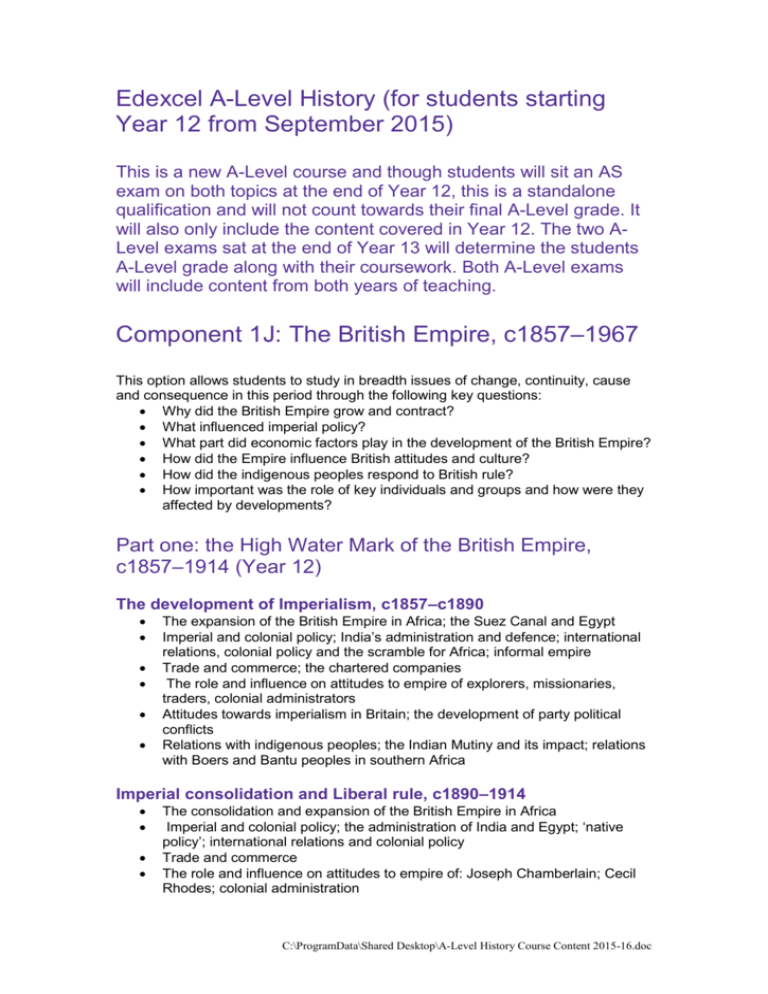
Edexcel A-Level History (for students starting Year 12 from September 2015) This is a new A-Level course and though students will sit an AS exam on both topics at the end of Year 12, this is a standalone qualification and will not count towards their final A-Level grade. It will also only include the content covered in Year 12. The two ALevel exams sat at the end of Year 13 will determine the students A-Level grade along with their coursework. Both A-Level exams will include content from both years of teaching. Component 1J: The British Empire, c1857–1967 This option allows students to study in breadth issues of change, continuity, cause and consequence in this period through the following key questions: Why did the British Empire grow and contract? What influenced imperial policy? What part did economic factors play in the development of the British Empire? How did the Empire influence British attitudes and culture? How did the indigenous peoples respond to British rule? How important was the role of key individuals and groups and how were they affected by developments? Part one: the High Water Mark of the British Empire, c1857–1914 (Year 12) The development of Imperialism, c1857–c1890 The expansion of the British Empire in Africa; the Suez Canal and Egypt Imperial and colonial policy; India’s administration and defence; international relations, colonial policy and the scramble for Africa; informal empire Trade and commerce; the chartered companies The role and influence on attitudes to empire of explorers, missionaries, traders, colonial administrators Attitudes towards imperialism in Britain; the development of party political conflicts Relations with indigenous peoples; the Indian Mutiny and its impact; relations with Boers and Bantu peoples in southern Africa Imperial consolidation and Liberal rule, c1890–1914 The consolidation and expansion of the British Empire in Africa Imperial and colonial policy; the administration of India and Egypt; ‘native policy’; international relations and colonial policy Trade and commerce The role and influence on attitudes to empire of: Joseph Chamberlain; Cecil Rhodes; colonial administration C:\ProgramData\Shared Desktop\A-Level History Course Content 2015-16.doc Imperialism: supporters and critics; National Efficiency; the British Empire and popular culture; representations of empire Relations with indigenous peoples; challenges to British rule; the Sudan; the causes and consequences of the Boer War Part two: Imperial retreat, 1914–1967 (Year 13: A-Level only) Imperialism challenged, 1914–1947 (A-Level only) Expansion and contraction of empire: the impact of the First and Second World Wars; the Mandates; withdrawal from India and the Middle East Colonial policy and administration in India, Africa and the Middle East; relations with the Dominions; the Statute of Westminster; imperial defence The development of trade and commerce; the economic impact of war The role and influence on attitudes to empire of: Gandhi, colonial administration Imperialist ideals; popular culture; representations of empire Relations with indigenous peoples; protest and conflict; colonial identity; the development of nationalist movements The winds of change, 1947–1967 (A-Level only) Decolonisation in Africa and Asia British colonial policy and administration; the Suez Crisis and its impact; international relations; the Commonwealth Trade and commerce; post-war reconstruction The role and influence on attitudes to empire of: nationalist leaders, colonial administration Post-colonial political, economic and cultural ties; migration; the residual impact of empire; popular culture Relations with indigenous peoples; challenges to colonial rule in Africa and Asia; Mau Mau; the growth of nationalist movements and reactions to them; Rhodesia C:\ProgramData\Shared Desktop\A-Level History Course Content 2015-16.doc Component 2R: The Cold War, c1945–1991 This option provides for the study in depth of the evolving course of international relations during an era of tension between communist and capitalist powers which threatened nuclear Armageddon. It explores concepts such as communism and anticommunism, aggression and détente and also encourages students to reflect on the power of modern military technology, what hastens confrontation and what forces promote peace in the modern world. Part one: to the brink of Nuclear War: international relations, c1945–1963 (Year 12) The Origins of the Cold War, c1945–1949 US, British and USSR relations in 1945: conflicting ideologies; tensions at Yalta; relations between Stalin, Roosevelt and Churchill; the breakdown of the Grand Alliance at Potsdam; relations between Stalin, Truman and Attlee Developing tensions: the Soviet Union occupation/control of eastern and southern Europe; Kennan's Long Telegram; the Iron Curtain speech; Cominform; the Greek Civil War and the Truman Doctrine on containment The USA’s involvement in Europe: policy towards Britain and Europe; the launch of the Marshall Plan; US attitudes to Germany and Berlin Conflict over Germany: developments within the sectors, including Bizonia and currency reform; the Berlin blockade; the creation of East and West Germany; formation of NATO The Widening of the Cold War, 1949–1955 US containment in action in Asia: the reconstruction of Japan and USJapanese relations; support for Jiang Jieshi and policy towards China and Taiwan; the defensive perimeter strategy; support for South Korea; NSC-68 The Korean War: causes, position and aims of Kim ll Sung and Syngman Rhee; attitudes and actions of the UN, USA, USSR and China; military involvement and settlement Increasing Cold War tensions: McCarthyism in the USA and its influence in Britain and Europe; US dominance in the UN and role as 'world policeman'; the isolation of China Alliances and shifts: FRG and NATO; the Warsaw Pact; SEATO; Eisenhower, Dulles and 'brinkmanship'; the domino theory; attitude to French struggle in Indo-China; the Geneva Conference The Global War, 1955–1963 Khrushchev and East-West relations: impact of risings in Poland and Hungary and Soviet intervention; the degree of 'peaceful coexistence', including exchange of visits and Paris summit Cold War rivalries: the extension of the arms race including ICBMs; the space race; sputnik and space flight; the Berlin Crisis and the U2 affair; the significance and impact of the Berlin Wall Conflict in Asia: Indo-China under Ho Chi-Minh in the North and Diem in the South; formation of NLF; Kennedy's policies towards Indo-China and Diem's assassination C:\ProgramData\Shared Desktop\A-Level History Course Content 2015-16.doc Confrontation between the superpowers: US attitudes to Cuba and developments leading to the missile crisis; the 13 days; the significance of the crisis Part two: from Détente to the end of the Cold War, c1963– 1991 (Year 13: A-Level only) Confrontation and cooperation, c1963–1972 (A-Level only) Confrontation in the Vietnam War: Johnson's policy in Vietnam; the Gulf of Tonkin resolution; escalation; tactics and relative strengths of the two sides; the Tet Offensive Nixon's policies in Vietnam: Vietnamisation; extension into Cambodia and Laos; relations with China; the beginning of the Paris peace talks Cooperation: attitudes of Khrushchev and Kennedy; Hot-line; Moscow Test Ban Treaty; nuclear non-proliferation treaty; cut back in materials for nuclear weapons Pressures on USSR: the crisis in Czechoslovakia and the Brezhnev doctrine; relations with China The Brezhnev era, 1972–1985 (A-Level only) The USA and SE Asia: Paris peace talks; Northern victory; continuing problems in Cambodia; costs of war The extent of Détente up to 1979: the SALT talks; Ostpolitik and Helsinki accords; arms race; relations with China The Second Cold War: the reasons for renewed hostilities and developments, including the Soviet invasion of Afghanistan; new personalities, including Reagan, Thatcher and Pope John Paul II; the crushing of Solidarity in Poland; the shooting down of KAL 007 Developments in Africa and the Americas: the impact of Cuban intervention in Angola and Ethiopia; the impact of US intervention in Latin America and the Caribbean including Chile, Grenada and Nicaragua The ending of the Cold War, 1985–1991 (A-Level only) Gorbachev and the ending of the Cold War: pressures on and significance of Gorbachev as Soviet leader; new thinking and practicalities: the importance of Soviet economic problems; The summits between the USA and the USSR, including Geneva, Reykjavik, Washington and Moscow; Reagan; star wars; Bush and the US response The collapse of Communism in the Eastern European soviet satellite states; the end of the Brezhnev Doctrine and significance of events of 1989 The ending of Cold War tensions in Asia: Afghanistan; the Americas: Cuba, Nicaragua and El Salvador; Africa: Angola and Ethiopia; the end of the Cold War: the Malta summit and its aftermath, including the reunification of Germany; the collapse of the USSR and resignation of Gorbachev C:\ProgramData\Shared Desktop\A-Level History Course Content 2015-16.doc Component 3: Historical investigation Students complete an historical investigation on a topic that pre-dates 1791 The essay is 3,500 words long The question is: To what extent was slavery the root cause of the American Civil War? Component weightings Component 1J: 40% Component 2R: 40% Component 3: 20% C:\ProgramData\Shared Desktop\A-Level History Course Content 2015-16.doc
